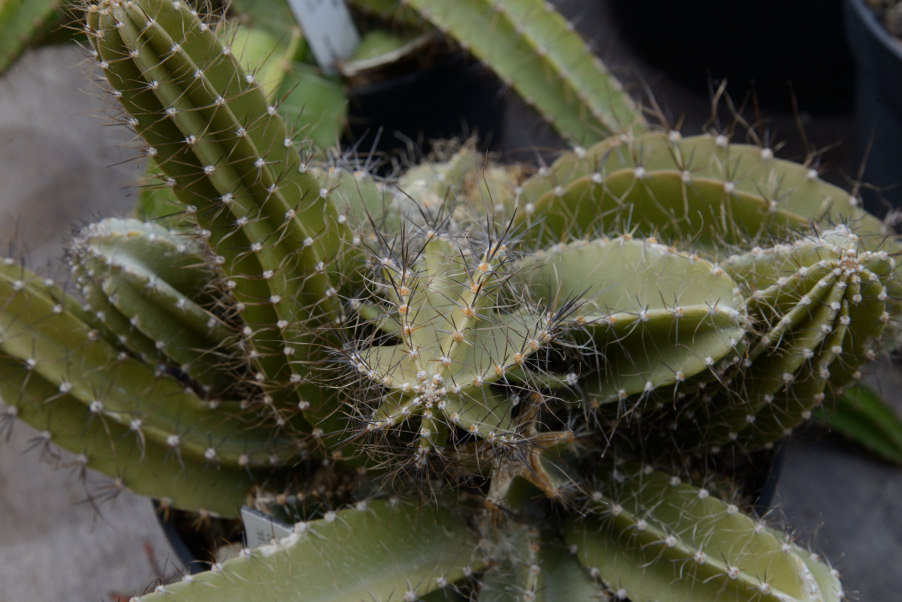
Deamia testudo
(Karw ex Zucc)Br&R
◊ Cact. 2:213" (1920)
◊◊ Cereus testudo Karw ex Zucc - Abh. Bayer. Akad. Wiss. München 2:682 (1837)
Cereus pterogonus Lem - Cact. Gen. Nov. Sp. 59 (1839)
Cereus pentapterus Otto - in: Salm-Dyck, Cact. Hort. dyck. 221 (1850)
Cereus miravallensis Web - Bull. Mus. Hist. Nat. Paris 8:459 (1902)
Selenicereus miravallensis (Web)Br&R - Contr. US Nat. Herb. 12:431 (1909)
Cereus acanthosphaera Wgt - Monatschr. Kakt. 24:81 (1914)
Deamia diabolica Clov - Bull. Torr. Bot. Club. 65:570 (1938)
Selenicereus testudo (Karw)Buxb - Krainz CIIa (1965)
Strophocactus testudo (Karw)Bauer - Cact. Syst. Init. 17:55 (2003)
- Climbing, on trees or rocks, up to 3 m long, stems up to 3 m long, 3-15 cm
diameter, variable in form, green. Ribs 3-5-8. Areoles up to 2.5 cm apart.
Spines 3-4, later more than 10, up to 2 cm long, rather stiff, yellowish,
later brown. Flower up to 28 cm long, 20 cm diameter. Ovary and receptacle
with dark hairs. Receptacle 10 cm long. Petals linear lanceolate. Outer
petals greenish. Inner petals whit to cream, spatulate-lanceolate. Filaments
light yellow. Pistil yellowish. Fruit spiny, red, yelowish or greenish, 6-9
cm long, with felt and short spines. Seed 1,5x3 mm, black.
- Mexico: Chiapas, Oaxaca, Quintana Roo, Tabasco, Veracruz, Yucatán; Belize (T: Corozal); Costa Rica:
Guanacaste; Guatemala: Izabal, Petén; Honduras: Atlántida,
Cortés, Francisco Morazán; Nicaragua: Estelí Colombia, up to
1000 m.
Cact. 2:213", 214"
Backeberg 2:771"
CSJ(USA) 31():156-157
Bravo 1:480, 481", 482"
KuaS 27(6):136"; 75(4):117"
Bravo 479, 480, 481", 482"
Bradleya 7:93
NCL 268:"
EPIG 8(3):84; 9(1):11"; 10(3):85"; 83:28"
◊ Cact. 2:213" (1920)
◊◊ Cereus testudo Karw ex Zucc - Abh. Bayer. Akad. Wiss. München 2:682 (1837)
Cereus pterogonus Lem - Cact. Gen. Nov. Sp. 59 (1839)
Cereus pentapterus Otto - in: Salm-Dyck, Cact. Hort. dyck. 221 (1850)
Cereus miravallensis Web - Bull. Mus. Hist. Nat. Paris 8:459 (1902)
Selenicereus miravallensis (Web)Br&R - Contr. US Nat. Herb. 12:431 (1909)
Cereus acanthosphaera Wgt - Monatschr. Kakt. 24:81 (1914)
Deamia diabolica Clov - Bull. Torr. Bot. Club. 65:570 (1938)
Selenicereus testudo (Karw)Buxb - Krainz CIIa (1965)
Strophocactus testudo (Karw)Bauer - Cact. Syst. Init. 17:55 (2003)
- Climbing, on trees or rocks, up to 3 m long, stems up to 3 m long, 3-15 cm
diameter, variable in form, green. Ribs 3-5-8. Areoles up to 2.5 cm apart.
Spines 3-4, later more than 10, up to 2 cm long, rather stiff, yellowish,
later brown. Flower up to 28 cm long, 20 cm diameter. Ovary and receptacle
with dark hairs. Receptacle 10 cm long. Petals linear lanceolate. Outer
petals greenish. Inner petals whit to cream, spatulate-lanceolate. Filaments
light yellow. Pistil yellowish. Fruit spiny, red, yelowish or greenish, 6-9
cm long, with felt and short spines. Seed 1,5x3 mm, black.
- Mexico: Chiapas, Oaxaca, Quintana Roo, Tabasco, Veracruz, Yucatán; Belize (T: Corozal); Costa Rica:
Guanacaste; Guatemala: Izabal, Petén; Honduras: Atlántida,
Cortés, Francisco Morazán; Nicaragua: Estelí Colombia, up to
1000 m.
Cact. 2:213", 214"
Backeberg 2:771"
CSJ(USA) 31():156-157
Bravo 1:480, 481", 482"
KuaS 27(6):136"; 75(4):117"
Bravo 479, 480, 481", 482"
Bradleya 7:93
NCL 268:"
EPIG 8(3):84; 9(1):11"; 10(3):85"; 83:28"